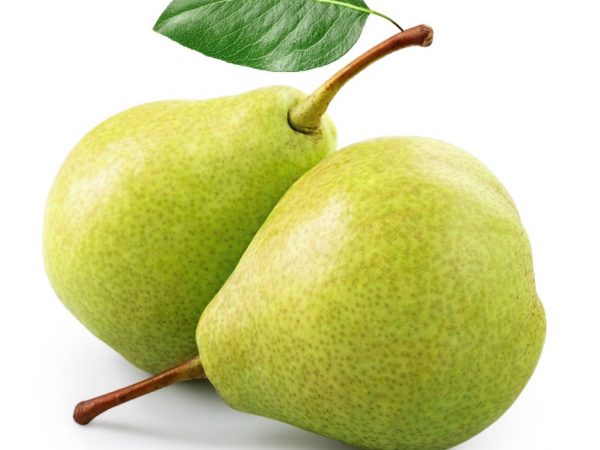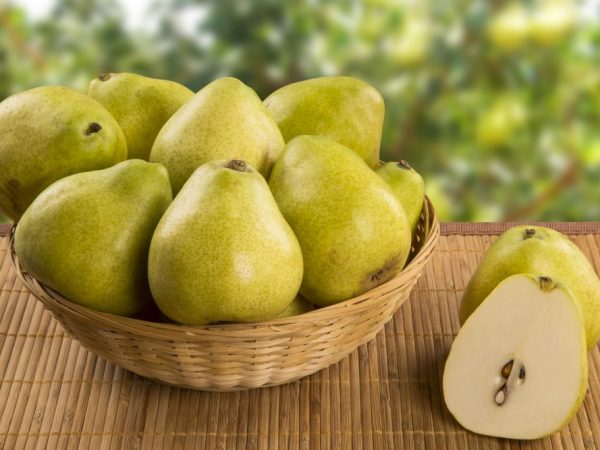Characteristics of the Yeseninskaya pear variety
Pear Yeseninskaya was bred with the help of scientists from VNIIPK. This is a special hybrid of selection crossing Severyanka, Koperechka, Bere Ligel, Lyubimitsa Klappa, Olivier de Serre.

Characteristics of the Yeseninskaya pear variety
Characteristic
The Yeseninskaya pear variety belongs to the autumn pear variety. Harvesting falls at the end of August - beginning of September. The duration of the consumer period is 2 months.
The advantages of this variety:
- yields a harvest annually;
- resists scab;
- early maturity;
- possesses high taste qualities of fruits.
Description of the tree
According to the description, the tree of this variety is of medium height, with a dense crown in the shape of a pyramid. Runs are brownish-brown, curved arcuate, no pubescence. The leaves are medium in size, shiny, dark green in color, the shape is like an oval, concave downward with a taper on one side. There are small notches along the edges of the leaf plate.
Flower buds are conical, smooth, large. The flowers are small or medium, white with separate petals, pale pink anthers.
Description of fruits
The fruit is medium, with a dense, rough skin. The fruit tastes sweet with a slight sourness, slightly oily, juicy. They can hang on a tree for up to two months. After removal, they are stored for up to 14 days in a cool place.
Chemical composition:
- 9.9% sugar;
- 113 mg / 100 g - P-active substances;
- 6.2 mg / 100 g - ascorbic acid;
- 0.38% - titratable acids;
- 4.4 mg - vitamin C.
Fruits of this variety can be used both fresh and for processing into compotes, jams, etc.
Growing
Soil preparation
Yeseninskaya pear is a popular species among gardeners. They plant it in places well protected from the wind. It is important to check the acidity level of the soil before planting. To do this, take a handful of soil, pour it into a container and pour in two or three tablespoons of vinegar. If bubbling and hissing do not appear, then the acidity level is increased. Slaked lime is used to reduce acidity: you need to mix soil and lime in a 5: 1 ratio, and only then plant a seedling.

With proper care of the pear, there will be a good result.
Landing in the soil
It is preferable to plant seedlings in clay-sandy soil with sufficient moisture, warmth and fertility.
Better to make a hole 50cm wide and 30cm deep. This is necessary so that the roots do not experience discomfort. When planting, you do not need to compact the soil, but simply press the near-stem zone.
Plant care
In the first year, it is important to carry out not only watering but also spraying of young leaves and twigs. The first few years also require the formation of the crown. Thinning of the ovaries is necessary every year for the correct development of the crop.
Fertilizer
To prevent fruit shedding, annual fertilization is required, preferably in early spring. Well-ripened manure or compost is suitable for this. It is necessary to mix organic matter in equal proportions (500 gr and 500 gr.).The mixture must be diluted in 20 liters. liquid, and water the plant with a solution.
Watering
The seedling needs intense moisture in the first years after planting, especially in dry weather. Therefore, it must be watered frequently. Older trees are much more drought tolerant.
Diseases and pests
Pear trees are prone to diseases such as scab and rot. With scab, shoots, leaves and fruits are affected. Pears fall off, and those that remain become ugly and cannot be stored.
Fruit rot that affects the crop appears as a small brown spot that constantly grows and turns black and blue. Affected fruits fall off.
Seedlings are also affected by insects. The most dangerous pests are:
- fruit and leaf gall midges;
- gall mites;
- tube wrenches;
- bedbugs;
- ticks;
- itching;
- moths;
- flower beetles;
- honeycloths.
If you do not take protective measures, there is a risk of losing your crop.
Fight disease
Ways to deal with scab:
- When budding and at the end of flowering, it is necessary to spray the tree with 1% Bordeaux solution or copper oxychloride.
- It is necessary to collect and destroy the fallen leaves and dig up the soil or spray the fallen leaves with mineral fertilizers: 7% urea, 10% ammonium nitrate, 15% ammonium sulfate or 7% potassium chloride, without touching the branches and trunk.
- With a large lesion, it is necessary to spray in the fall using a 4-5% urea solution, and in early spring to use nitrophos.
When fighting fruit rot, you need to collect and remove volunteers from the garden in the summer, and in the fall to collect and burn all mummified fruits.
Pest control
To get rid of pests, it is required in early spring, before flowering, to spray trees with insecticides, clearing them before that from dead bark, lichens and moss. Twisted leaves with nests should be destroyed regularly.
In the fall, the soil around the trees must be dug up. The larvae are removed on a litter spread around.
Prophylaxis
For prophylaxis against diseases, blooming leaves are treated with Bordeaux liquid (1%) before flowering. You can prepare a solution for processing as follows: for 20 liters. liquid, add 300g. vitriol and 200 gr. slaked lime. The mixture must be thoroughly stirred and sprayed on the crown of a young tree in spring in early April.
Conclusion
Yeseninskaya pear withstands winter well, but at very low temperatures, fruit formations can freeze. It is important to remove ripe fruits carefully and with a stalk. Otherwise, they are only suitable for recycling. Before winter, you need to wrap the seedlings with earth and sawdust to protect the root from frost.


